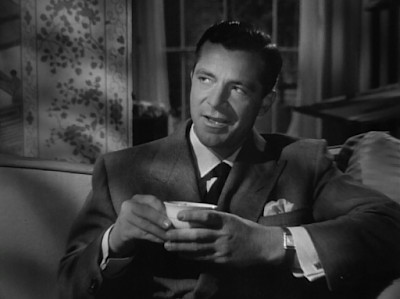Directed
by Otto Preminger
Screenplay
by David Hertz
Based on
the novel Daisy Kenyon by Elizabeth
Janeway
Music by
David Raksin
Edited by
Louis R. Loeffler
Cinematography
by Leon Shamroy
Joan Crawford as Daisy Kenyon
Dana Andrews as Dan O’Mara
Henry Fonda as Peter Lapham
Ruth Warrick as Lucille O’Mara
Martha Stewart as Mary Angelus
Peggy Ann Garner as Rosamund O’Mara
Connie Marshall as Marie O’Mara
Nicholas Joy as Coverly
Art Baker as Lucille O’Mara’s
attorney
Distributed
by Twentieth Century-Fox Film Corporation
I didn’t expect to
like Daisy Kenyon much. I’m not a big
fan of Henry Fonda. I always admire Joan Crawford’s work, but I was convinced
she would be overpowering in the title role. I have since learned that Henry
Fonda and Dana Andrews didn’t want their respective roles for almost the same
reason: They were afraid they would not have much to do in what they assumed would
be a Joan Crawford vehicle. But Dana Andrews was enough to convince me to see Daisy Kenyon: He is one of my noir
favorites. And I wondered why a film about a single woman having an affair with
a married man while dating and then marrying another would be called a film
noir.
(This blog post about
Daisy Kenyon contains the spoiler.)
After
seeing the film the first time, I wasn’t entirely convinced that Daisy Kenyon could be called film noir.
Foster Hirsch, in the audio DVD documentary, makes the same point I have made
about other films: that Daisy Kenyon can belong in more than one category, and Hirsch
chooses film noir and the rather outdated category of women’s film. I would
call the film about 35 percent noir and 65 percent romantic drama.
I found
myself wondering which man Daisy would choose: Peter Lapham or Dan O’Mara, a
point that absorbed me completely while following the story. Foster Hirsch mentions
in his commentary that the production code at the time wouldn’t have allowed
Daisy Kenyon to break up Dan O’Mara’s marriage; thus, viewers today should know
the answer to Daisy Kenyon’s dilemma. For once, I’m glad I didn’t put two and
two together before I watched Daisy Kenyon!
The
cinematography is well-suited to the story. And the story is pretty realistic
about the characters and their emotions. The use of light and shadow in the
framing of many scenes is what helps make Daisy
Kenyon a film noir. The story is not a glamorous and fun portrayal of
romance, that much is certain. I think the film does an excellent job of
showing violence and the threat of it between romantic partners—even if its
overall approach is muted for the production code in place during the 1940s.
Henry Fonda’s
character, Peter Lapham, is a World War II veteran who suffers from
post-traumatic stress disorder. His emotional turmoil is part of the narrative
and complicates his relationship with Daisy. What I find interesting about the
film is that Peter Lapham, in spite of his emotional vulnerability, is the one
who outmaneuvers Dan O’Mara. Peter tells Daisy that he knows a thing or two
about tactical maneuvers, and he uses it to his advantage in his romantic life.
I watched many of the
features that were provided on the DVD (DVD release © Twentieth Century Fox
Home Entertainment LLC), including the following:
◊ “From Journeyman to Artist: Otto Preminger at Twentieth
Century Fox”
◊ “Life in the Shadows—The Making of Daisy Kenyon”
◊ Audio commentary by film historian Foster Hirsch
What really struck me
as an overarching theme for all of these features was this: male reviewers and
commentators telling viewers that Joan Crawford was too old for the part of
Daisy Kenyon. I have to admit that I got really tired of hearing that
opinion—again and again.
Foster Hirsch
mentions that the character of Daisy Kenyon in the novel by Elizabeth Janeway is
thirty-two and that Joan Crawford (at age forty-three when the film was
released) had passed the Hirsch imaginary cutoff point for age appropriateness
in the torn-between-two-lovers dilemma. (Dana Andrews was almost thirty-nine
when the film was released; Henry Fonda was forty-two.) According to Hirsch, everyone
leaves all doubt and confusion behind when they age out of their thirties! Not
one mention is made of Dana Andrews’s portrayal of a married man who is
romantically confused enough to be carrying on an affair and isn’t quite sure
whether he loves his wife or his mistress, or whether he loves them both
equally. And not one mention is made about Dana Andrews being age-inappropriate
for the part of Dan O’Mara.
Foster Hirsch also
describes the Dan O’Mara character as being “cold.” “Cold,” Mr. Hirsch, is an
understatement. In one scene, Dan O’Mara threatens to kill his wife Lucille. In
another, he physically assaults Daisy Kenyon in her apartment. The only thing
that stops him is the appearance of her friend Mary Angelus at the front door
of Kenyon’s apartment. I would say that Dan O’Mara is more than “cold,” Mr.
Hirsch: He has a cruel and violent streak.
Please don’t
misunderstand me: I am not suggesting that you pass up these DVD features. They
were also packed with a lot of great information: about the production of the
film, the three stars (Joan Crawford, Dana Andrews, and Henry Fonda), the
director Otto Preminger. But you will have to wade through a lot of male
opinion (and it is opinion) about how
a woman should be conducting her romantic life. And it may be disconcerting to
discover that the male commentary provided by a male film historian in 2008
about a film released in 1947 shows how little has changed since 1947. The DVD
was released in 2008—before the Me Too movement; let’s hope more has changed in
the last ten years and continues to change.




No comments:
Post a Comment